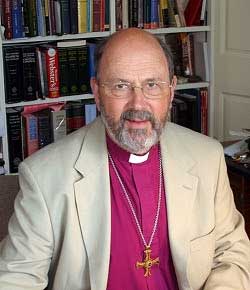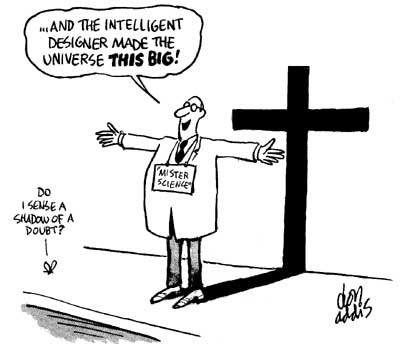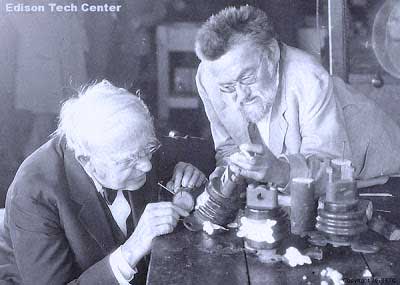
N. T. Wright refuses to call himself an inerrantist, accepts evolution, but also defends all of the miraculous tales found in the Gospels, and stresses Godʼs goodness and love above all. Those opinions along with his view that leaders of the Reformation misunderstood Paul, have rankled not a few conservative Christian feathers. And it looks like he will be rankling more with his upcoming contribution to John Waltonʼs new book on Genesis. See for instance:
Quotations From N. T. Wright
“I grew up in a church-going family, a very sort of ordinary, middle-of-the-road Anglican family where nobody really talked about personal Christian experience. It was just sort of assumed like an awful lot of things in the 1950ʼs were just sort of taken for granted. So you went to church. It was assumed you said your prayers. You read your Bible.”
“Within that context, and with having lots of members of my family who were in ministry in one form or another, I suppose it shouldnʼt be surprising that at quite an early age, I was very, very conscious personally of the love of God.”
“I remember one particular moment (I donʼt actually know how old I was, but I guess around 7 or something like that) when I remember actually weeping. I was by myself in a room in the house, and I was just crying because I realized how much Jesus loved me. I have a clear memory of me as a little boy doing that. Iʼve no idea whether it was [because] Iʼd heard a sermon or something in a hymn or just something had come home to me.”
“I knew around that time that I had to be a preacher. I had to be a minister, which was a puzzle to me because my dad was a businessman. It was a family company and I assumed that I would take it on from him. So I kind of agonized as a small boy about how that was going to work. And then when it became clear that in fact my father was saying, ‘It will be interesting to see what you want to do when you grow up,’ I realized that there was no pressure on that front. And I remember huge relief: Hey, I can go and do what I really know I have to do!
“Throughout that time and then different stages through my teens… Through my teens, I was very much in contact with the evangelical movement through Scripture Union and Boysʼ Camps that I used to go on as a teenager and then through into my early twenties. And that would be twice a year… go off to Scotland and stay under canvas and go climbing and sailing and canoeing and all that stuff… but really good Bible teaching, morning and evening. And gradually I started to take a part in leading Bible studies and all of that.”
“Through my teens, my own personal Christian experience was just growing in a variety of ways — and basically learning how to pray and finding my way around the Bible. Funny but, for me, the Bible was a hobby before it was a serious study. It was the thing Iʼd sneak off and do on the side, feeling rather guilty because I wasnʼt doing my real school homework or whatever… and never thinking I would make it a lifeʼs work.”
“So I was enormously fortunate in all of that. I was ordained in my mid-twenties.”
“I guess, as an Anglican, thereʼs always room to move, which can be a dangerous thing, but also a very healthy thing… it gave me the space, enabled me to grow…
“I donʼt have a Damascus road experience to record. I donʼt have anything like that. Itʼs kind of a steady growth with some wonderful movements in the middle of it.”
N. T. Wright, in a podcast interview with Trevin Wax on Thursday, November 15, 2007 at Asbury Seminary
“I did learn an enormous amount by reading C. S. Lewisʼs main theological works, most of them two or three times, at a formative stage in my late teens. Even though I firmly disagree with C. S. L. on some things now I still regard him as having taught me some of what I know about how to think.”
N. T. Wright Q & A from September 2004.
“I went to Canada in 1981 to teach NT studies at McGill… During my second year at McGill, I plunged into the deepest depression Iʼve ever known. I wrestled in prayer, searched the scriptures, examined my conscience, and fell apart. I told my wife about it one night; the next morning, a letter arrived from a Christian psychotherapist who had felt an inexplicable but irresistible urge to write. I still have that letter. Over the next year I learned more about myself and my emotions than I had thought possible. If today I manage to function as a pastor, it is not least because I know something about pain. I know, too, that healing of memory and imagination is not just wishful thinking… Six years later, as I prepared to teach a course on Jesus in his historical context, I realized what else had been happening. I combed through my notebooks for all my old jottings. All the most significant insights about Jesus I had ever had, particularly my deepest reflections on the crucifixion, were dated in that period of depression… Passages from Scripture still jump off the page and make me want to laugh and/or cry with the love and the pain, of God. Unanswered questions remain. So does the frailty of my human self, as I struggle to be obedient to my multiple callings, both professionally and, more important (though not all Christians see this point), domestically. Who is sufficient for these things? Certainly not this muddled and sinful Christian. The great thing about that is what it does for your theology. The more I appreciate my own laughable inadequacy, the more I celebrate the fact of the Trinity. Without the possibility of invoking the Spirit of Jesus, of the living God, for every single task, what would keep me going? Pride and fear, I guess. I know enough about both to recognize the better way.”
Tom Wright, My Pilgrimage in Theology (Originally Published in Themelios, January, 1993, 18.2, 35. Reproduced by permission of the author.)
“The Jesus I have discovered through historical research is… not the Jesus I expected or wanted to find when I began this work nearly twenty years ago. Studying Jesus has been the occasion for huge upheavals in my personal life, my spirituality, my theology, and my psyche… Second, the Jesus I have discovered is clearly of enormous relevance to the contemporary world and Church. I know that others with very different Jesuses would say this as well, so you may find the point irrelevant… Let me put it like this. After fifteen years of serious historical Jesus study, I still say the creed ex animo; but I now mean something very different by it, not least by the word ‘god’ itself.”
N. Thomas Wright, “Jesus and the Identity of God” (Originally published in Ex Auditu 1998, 14, 42—56. Reproduced by permission of the author.)
“Well-known problems abound [with the nativity tales about Jesus in the Gospels]. Why does the genealogy finish with Joseph if Matthew is going to say that he wasnʼt Jesusʼ father after all? This cannot have been a problem for Matthew or he would hardly have followed the genealogy so closely with the story of the virginal conception. It was enough that Jesus was born into the Davidic family; adoption brought legitimation. Further, anyone can say that Matthew made it all up to fulfill Isaiah 7:14 (‘the virgin shall conceive’). Since Luke doesnʼt quote the same passage, though, the argument looks thin. Is Bethlehem mentioned only, perhaps, because of Micah 5:2-4? Again, Luke doesnʼt quote the same passage, but still gets Mary to Bethlehem for the birth. Some have questioned whether Herod would really have behaved in the way described in Matthew 2; the answer, from any reader of Josephus, would be a firm yes.”
“One can investigate, as many have, whether there really was a star. One can challenge the flight into Egypt as simply a back-projection from a fanciful reading of Hosea 11:1. These are the natural probing questions of the historian. As with most ancient history, of course, we cannot verify independently that which is reported only in one source. If that gives grounds for ruling it out, however, most of ancient history goes with it. Let us by all means be suspicious, but let us not be paranoid. Just because Iʼve had a nightmare doesnʼt mean that there arenʼt burglars in the house. Just because Matthew says that something fulfilled scripture doesnʼt mean it didnʼt happen…”
“Attention has focused on the census in Luke 2:2-whether it took place and could have involved people traveling to their ancestral homes. But Lukeʼs point has been missed. The census was the time of the great revolt-the rebellion of Judas the Galilean, which Luke not only knows about but allows Gamaliel to compare with Jesus and his movement (Acts 5:37). Luke is deliberately aligning Jesus with the Jewish kingdom-movements, the revolutions which declared that there would be ‘no king but God.’”
“The census is not, of course, the only query that people have raised about Lukeʼs birth stories. Jesusʼ birth at Bethlehem seems to have been a puzzle to Luke, which he explains by the census, rather than something he invents for other reasons. The fact that Luke does not mention the wise men, nor Matthew the shepherds, is not a reason for doubting either; this sort of thing crops up in ancient historical sources all the time. Of course, legends surround the birth and childhood of many figures who afterwards become important. As historians we have no reason to say that this did not happen in the case of Jesus, and some reasons to say that it did. But by comparison with other legends about other figures, Matthew and Luke look, after all, quite restrained…”
“No one can prove, historically, that Mary was a virgin when Jesus was conceived. No one can prove, historically, that she wasnʼt. Science studies the repeatable; history bumps its nose against the unrepeatable. If the first two chapters of Matthew and the first two of Luke had never existed, I do not suppose that my own Christian faith, or that of the church to which I belong, would have been very different. But since they do, and since for quite other reasons I have come to believe that the God of Israel, the worldʼs creator, was personally and fully revealed in and as Jesus of Nazareth, I hold open my historical judgment and say: If thatʼs what God deemed appropriate, who am I to object?”
N. T. Wright, “Godʼs Way of Acting,” The Christian Century, December 16, 1998, pp. 1215-17.
“Well, in terms of method, sola Scriptura is what Iʼve always tried to do, basically. You could put it negatively… If you find yourself thinking down a track where you think, Oh, well, if I go there, thatʼll mean ditching this bit of the Bible or that bit, then all sorts of warning lights flash and say, “You probably shouldnʼt be going there!” It may be that youʼve misheard your own mind, as it were, and there may be a way through this because there are always puzzles that we hit, but basically, my aim has been to expound Scripture and to expound Scripture in such a way that I do not set one Scripture over against another.
“However, I have to say, and my work on the authority of Scripture, which you probably know — a little book called The Last Word in America. Silly title, by the way. That was Harperʼs folly to call it that. It wasnʼt my idea. Fancy having a book called The Last Word! I mean… itʼs very silly. If I was going to write a book called The Last Word it would be on Christology, not on Scripture. ‘In the last days, God has spoken to us by his Son…’”
“But Iʼve been trying to stress that the risen Jesus does not say to the disciples, ‘All authority on heaven and earth is given to the books you chaps are going to go off and write.’ He says, ‘All authority on heaven and earth is given to Me.’ So that if we say that Scripture is authoritative, what we must actually mean is that the authority which is vested in Christ alone is mediated through Scripture.”
“Thatʼs a more complicated thing than simply having a book on the shelf, full of right answers that you can go and look up. Itʼs more a way of saying that when we read Scripture and determine to live under it, we are actually saying we want to live under the sovereign lordship of Jesus mediated through this book.”
“When you say it like that, then all sorts of other things happen as a result, like what is the sovereign lordship of Jesus all about? Is it simply to fill our heads with right answers to difficult questions? Well, right answers to difficult questions are better than wrong answers to difficult questions. But no, the authority of Jesus Christ is there to transform and heal and save the world, to make the kingdoms of the world become the kingdom of our God and of his Christ. So the question then is, how does the authority of Scripture serve that purpose?. And thatʼs actually much more interesting than simply using Scripture to settle or raise indeed doctrinal disputes within the church.”
N. T. Wright, in a podcast interview with Trevin Wax on Thursday, November 15, 2007 at Asbury Seminary
“As we read scripture, we struggle to understand what God is doing through the world and through us. The phrase ‘authority of scripture’ can make Christian sense only if it is shorthand for ‘the authority of the triune God, exercised somehow through scripture.’ When we examine what the authority of scripture means weʼre talking about Godʼs authority which is invested in Jesus himself, who says ‘All authority in heaven and on earth has been given to me. (Matthew 28:18, NRSV).’
N. T. Wright, in, “Heavy Theological Dude Mistakenly Talks to Us,” Becky Garrison, The Wittenburg Door Interview: N.T. “Tom” Wright, 12/17/2007
“I do not think Jesus ‘knew he was God’ in the same sense that one knows one is hungry, or thirsty, tall or short. It was not a mathematical knowledge. It was more like the knowledge that I have that I am loved by my family and closest friends; like the knowledge that I have that sunrise over the sea is awesome and beautiful; like the knowledge of the musician not only of what the composer intended but of how precisely to perform the piece in exactly that way-a knowledge most securely possessed, of course, when the performer is also the composer. It was, in short, the knowledge that characterizes vocation. As I have put it elsewhere: ‘As tested in confrontation, agonized over in further prayer and doubt, and implemented in action, he [Jesus] believed he had to do and be, for Israel and the world, that which according to Scripture only YHWH himself could do and be.’ ‘Awareness of vocation’ is by no means the same thing as Jesus having the sort of ‘supernatural’ awareness of himself, of Israelʼs God, and of the relation between the two of them such as is often envisaged by those who, concerned to maintain a ‘high’ christology, place it within an eighteenth-century context of implicit Deism where one can maintain Jesusʼ ‘divinity’ only by holding some form of docetism.”
N.T. Wright, The Challenge of Jesus, Downers Grove: InterVarsity Press, 1999) p. 121-122
[Personally, I think Wright is just saying he is sure Jesus was God, but he canʼt prove even Jesus was certain of it.]
“The way I see it is that there were many hominids or similar creatures, part of the long slow process of Godʼs good creation. And at a particular time God called a particular pair for a particular task: to look after his creation and make it flourish in a whole new way. Actually, this fits with the scientific evidence according to which there were some significant changes in the hominid population and lifestyle around 6000 years ago, though I wouldnʼt myself put too much weight on that.”
“N.T. Wright on the Bible and why he wonʼt call himself an inerrantist,” Jonathan Merritt on Faith and Culture, Religious News Service, June 2, 2014
“I do think there was a primal pair in a world of emerging hominids, thatʼs the way I read that… But it seems to me that just as God called Abraham and Sarah out of a welter of wandering nations and said Iʼve got a special purpose for you, the way that I see it is that God called one pair of hominids and said ‘OK, this place is a bit chaotic, you and I together, weʼre going to have a project. Weʼre going to plant this garden and weʼre going to go out from here and this is how itʼs going to be.’ So when Cain goes off he founds a city. Excuse me, who else is in the city?… And ancient Jewish readers knew this perfectly well, they knew that this was not the first ever humans or anything like them.”
“NT Wright on Paul, Hell, Satan, Creation, Adam, Eve & more,” Unbelievable? [radio/podcast], Friday 1st November 2013
N. T. Wright Focuses on Love & Goodness
“At quite an early age, I was very, very conscious personally of the love of God… I realized how much Jesus loved me… God says, “You are my beloved child. With you I am well pleased.” The verdict of the future is brought forward into the present on the basis of faith and faith alone, and faith is the result of Godʼs grace through the gospel of Jesus crucified and risen… The verdict of justification is God saying over faith, ‘This really is my beloved child.’… Paul slices straight in with the Isaianic message: Good news! God is becoming King and he is doing it through Jesus! And therefore, phew! Godʼs justice, Godʼs peace, Godʼs world is going to be renewed. And in the middle of that, of course, itʼs good news for you and me. But thatʼs the derivative from, or the corollary of the good news which is a message about Jesus that has a second-order effect on me and you and us… God is the Creator God, he doesnʼt want to say, ‘Okay, creation was very good, but Iʼm scrapping it.’ He wants to say, ‘Creation is so good that Iʼm going to rescue it.’… Godʼs going to do the great thing in the future, and my goodness, heʼs doing it with us already in the present!… When you announce that Jesus Christ is the Lord of the world, crucified and risen, you are simultaneously saying, ‘And you need to believe in him for your own present and eternal justification and salvation,’ but also ‘this means that he is claiming the whole creation as his own and wants to renew and restore it and flood it with his justice and his love, and if youʼre signing on to believe in him, youʼve got to be part of that project.’ If he is not Lord of all, he is not Lord at all… [Jesus] believed that Godʼs purposes to rescue the whole world were coming to fulfillment. He died to take the weight of evil upon himself. He rose to launch Godʼs project and to invite the whole world to join in with it and find it for themselves… I went to do a public debate with Ted Yarnold whoʼs one of the great Catholic theologians at Oxford, sadly dead now. We went off to a big ecumenical gathering in Reading, between Oxford and London, and we chatted in the car about who would speak first. I said, “Well, youʼre the senior here. You better go first and lead off.” So he did. He began by saying, ‘Letʼs just remind ourselves what the doctrine of justification is. It is that thereʼs nothing whatever we can do to earn Godʼs favor. It must come entirely from Godʼs grace. And the only thing that we can possibly do is nothing of ourselves, merely believe in the astonishing goodness and grace of God.’ And I stood up and said, ‘We might as well go home because obviously weʼre on the same page here. If your chaps had been saying this 400 years ago, we mightnʼt have got into all this problem.’… I think thereʼs been an enormous amount of misunderstanding. I have met many Roman Catholic theologians who will emphasize as much as any good Protestant preacher that everything comes from the love and grace of God… The great thing we have to work at (and a tip of the hat to the Catholic bishops ten years ago who wrote a document called ‘The Common Good’), weʼve got to rediscover that there are, as Oliver Donovan says, ‘common objects of love.’… The gospel is about the recreation of the whole world and included in that is lots of stuff about common good which we can actually agree on. And we have to work on that locally, culturally, nationally - to build relationships of trust and mutual respect. That doesnʼt mean that we donʼt do evangelism. Paradoxically, it means that if we show that we respect people, we actually earn the right to be heard. If we show that we donʼt respect them, we will never be heard.”
N. T. Wright, in a podcast interview with Trevin Wax on Thursday, November 15, 2007 at Asbury Seminary
Criticisms From Dale Allison, Larry Hurtado, Edward Adams, Thom Stark & Others
“These lame words [of Wrightʼs] lack all historical sense. They are pure apologetics, a product of the will to believe, and a prize illustration of theological predispositions moving an intelligent man to render an unintelligent verdict.”
– Dale C. Allison Jr. on N.T. Wrightʼs belief in a literal interpretation of the “many risen saints” passage in Matthew 27:51-53, The Historical Christ and the Theological Jesus. Grand Rapids and Cambridge: Eerdmans, 2009, p. 21.
“To his credit, Wright makes no attempt to conceal this apologetic concern… One curious matter to mention is that, whereas on one page Wright agrees that ‘there was a wide spectrum of belief in second-Temple Judaism regarding the fate of the dead.’ (p. 201), a few pages later he contends that, except for those like the Sadducees who resisted the idea, ‘resurrection had been woven into the very fabric of first-century Jewish praying, living, hoping and acting’ (p. 204), and that in Jesusʼ time ‘most Jews believed in resurrection,’ although there remained a certain diversity about what the resurrection body would be like (p. 205)… Part Four (chaps. 13-17) is a detailed analysis of the canonical Gospelsʼ accounts of Jesusʼ resurrection… One question that readers may judge less than adequately handled is whether the variations among the Gospel narratives reflect ‘only minor development’ (p. 611) in traditions about Jesusʼ resurrection in the first century.”
– Larry Hurtado, reviewing Wrightʼs book on the resurrection, The Expository Times, 115:3 Dec. 2003, p. 83-86.
Edward Adams (biblical scholar) and Thom Stark (a seminarian) have demonstrated Wrightʼs ignorance when it comes to researching and understanding apocalyptic. See The Stars Will Fall by Edward Adams, and, The Human Faces of God by Thom Stark. Here is a review of Adamsʼ book, The Stars Will Fall, published by the Society of Biblical Literature: Starkʼs book has a chapter on Jesus the apocalyptic prophet, titled,“Was Jesus Wrong?” Stark read Wright throughout seminary, and was a big fan, however after studying Wrightʼs attempts to reinterpret prophecies of a literal return of the Son of Man/the Lord throughout the NT, Stark points out why Wrightʼs view fails to explain the passages in question.
“The first thing to be said about the evangelical mind, wrote Mark Noll in his much discussed The Scandal of the Evangelical Mind, ‘is that there is not much of an evangelical mind.’ In recent years, however, that has changed dramatically, according to… a cover story in Christianity Today magazine celebrating ‘The New Theologians’ (N. T. Wright, Kevin Vanhoozer, Richard Hays, Ellen Charry, Miroslav Volf). Christianity Today exults in the fact that such figures, who are not ashamed to be called evangelicals, are teaching at universities such as Yale and Duke where the liberals—in antithesis to whom evangelicals define themselves—once held undisputed sway. The CT message is, partly, that we now have some of ‘our’ people planted behind the enemy lines and, partly, that a few members of the C[hristian] team are playing with the A team. The distinctly defensive tone is perhaps to be expected in the mainline (if one may be permitted the term) publication of evangelicals who are self-consciously outsiders… They give reason to believe that the time is in sight when it will not be accurate to say that ‘there is not much of an evangelical mind.’ Then comes along evangelical sociologist James Davison Hunter of the University of Virginia to rain on the party. The question he has been asking in a number of scholarly books is: ‘Maybe so. But will they then still be evangelicals?’”
– Richard John Neuhaus, “The Evangelical Mind, Again,” The Public Square, First Things 93 (May 1999): 77-95.







